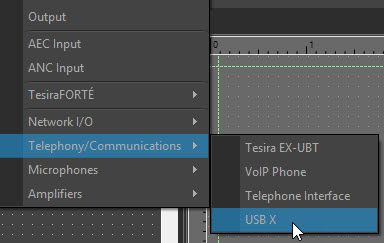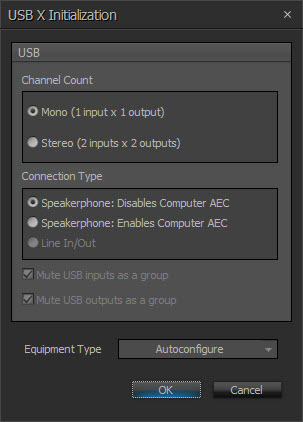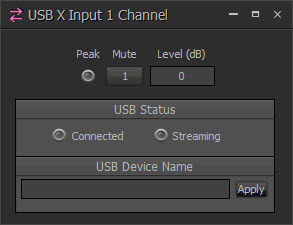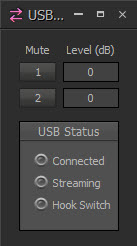USB X
USB X is available on TesiraFORTÉ X and EX-UBT devices (see EX-UBT for USB information specific to that device). The USB initialization dialog allows the selection of three different operational modes. See the USB considerations section for more details. USB connections may require the Asynchronus clocking mode to be disabled. Please review the USB_Clocking section if audible artifacts are heard on USB streams.
Initialization Dialog
Configurations for the Tesira USB X are available from the Object Toolbar via the Telephony/Communications menu item:

When the USB X object type is selected from the Audio Object Toolbar, the USB X Initialization dialog window is displayed:

USB X Channel Count - This allows the user to select between three different channel configurations:
-
Mono 1 input x 1 output channel
-
Stereo 2 input channels x 2 output channels
USB X Connection Type - The two Speakerphone modes provide single or stereo audio input and output streams for use with a soft codec application on a PC. The USB X Input represents the incoming audio from the soft codec and the USB X Output is used to send audio to the far side.
-
Speakerphone: Disables Computer AEC – In this mode, the Acoustic Echo Cancellation (AEC) function will be provided by the AEC block in the Tesira audio DSP. A control message is transmitted to the soft codec via the USB link telling it to disable its internal AEC.
-
Speakerphone : Enables Computer AEC – This mode is for situations where the soft codec will provide the AEC function.
-
Line In/Out – This mode provides 2 channels of audio and operates in fixed 24/16 Bit, 48 kHz.
Mute USB X Inputs as a group - Mutes all USB X input channels when the mute state of a single input channel is changed. This selection is checked and cannot be deselected if either of the Speakerphone USB X terminal types is selected. It is also checked by default if the Line In/Out USB terminal type is selected.
Mute USB X Outputs as a group - Mutes all USB X output channels when the mute state of a single output channel is changed. This selection is checked and cannot be deselected if either of the Speakerphone USB terminal types is selected. It is also checked by default if the Line In/Out USB terminal type is selected.
Notes on host operating system controls:
-
"USB host" refers to the USB X on the PC.
-
Balance controls will not be synchronized between the USB X input block and the USB X host when in speakerphone mode (only playback levels are).
-
The USB X Block initializes minimum level to -50 to more accurately map to the host PC volume ramp range and rate. Various operating systems (Microsoft, Chrome, OS etc.) may have minor behavior differences regarding mute at minimum level.
-
In Speakerphone modes the min/max levels can be exceeded by the USB host device.
-
In speakerphone mode the minimum/maximum levels of the EX-UBT USB X Input Block can only be adjusted while the software is offline (they are read-only when the software is connected to the system). The audio volume will not change while moving the slider in the USB X Input Block (left/right) until the mouse is released.
-
Changing the minimum/maximum via TTP is prohibited when in speakerphone mode.
DSP Block Representation


Input Output Control Dialog:

| Name | Description | Range |
| Peak | A software indicator that flashes when the input signal is within 6dB of clipping | Dark - Off Red - On |
| Mute | Turns the input signal on/off. | Dark - Off Red - On |
| Level | Adjusts the relative input volume | -100 to 0 |
| USB Status | Connected and Streaming status are shown | Dark - Off Green - On |
| USB Device Name | Allows entering a USB device name which will be visible in Windows. The USB device name only supports alphanumeric characters and spaces. Do not use spaces at the beginning or end of the device name. If left blank, the default naming will be EX-UBT<serial number>. |

| Name | Description | Range |
| Mute | turns the input signal on/off. | |
| Level | adjusts the relative output volume | -100 to 0 |
| USB Status | Connected and Streaming status are shown | Dark - Off Green - On |